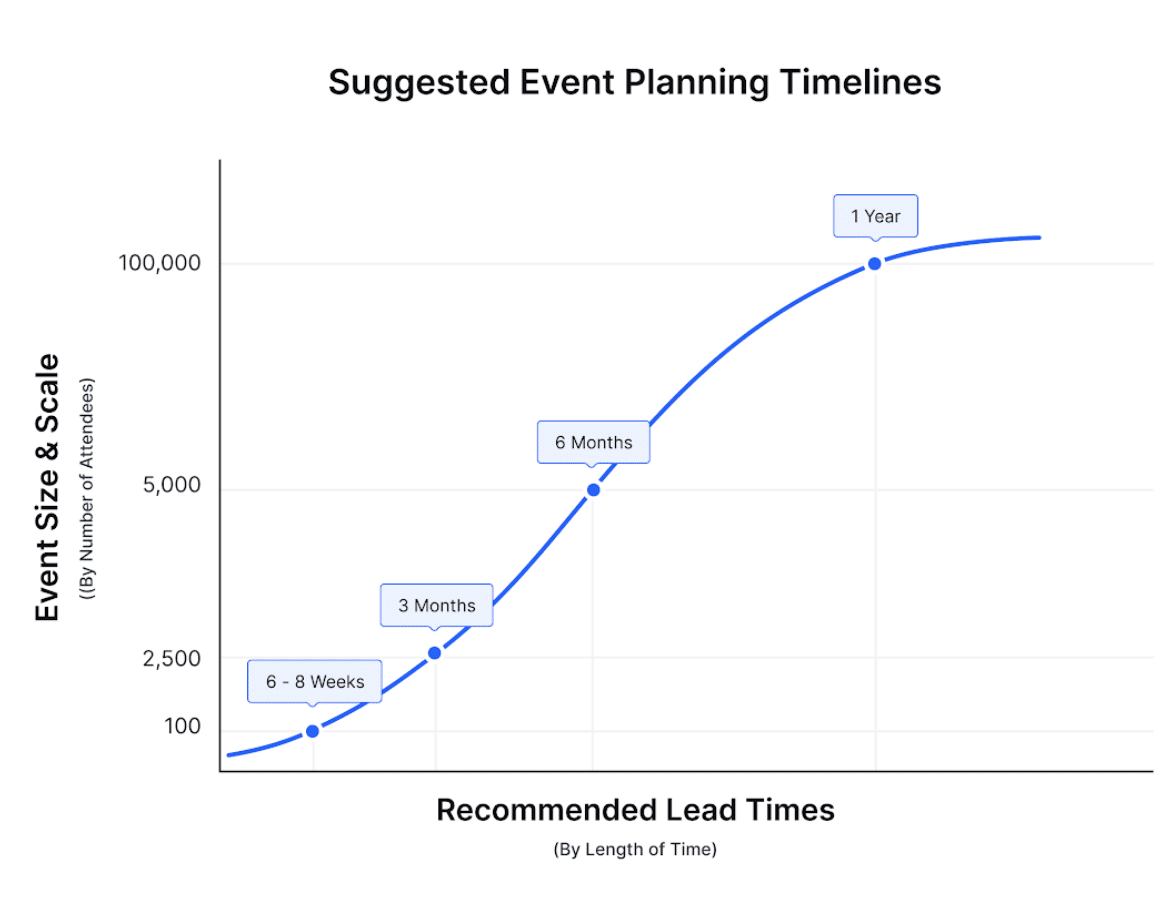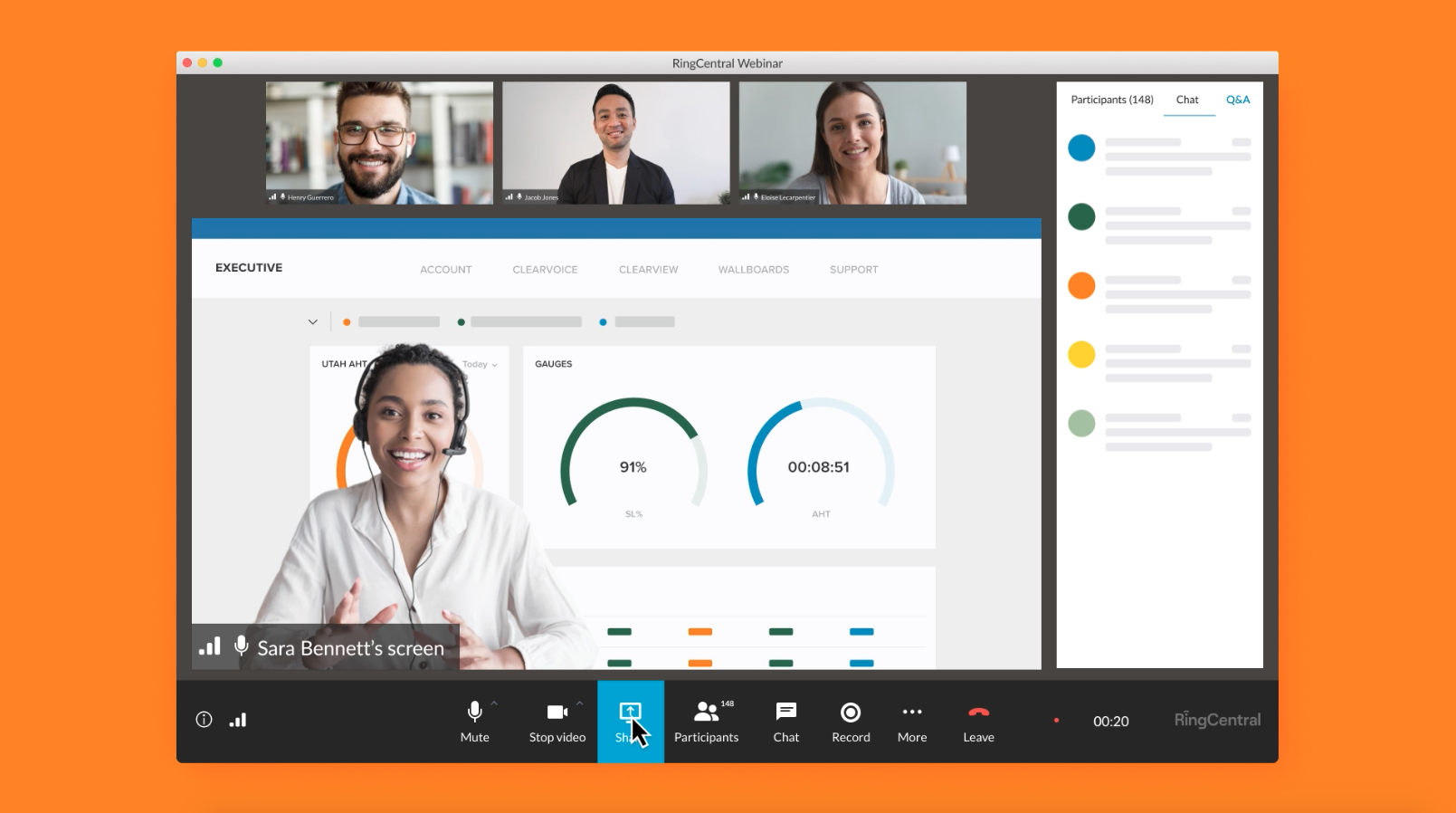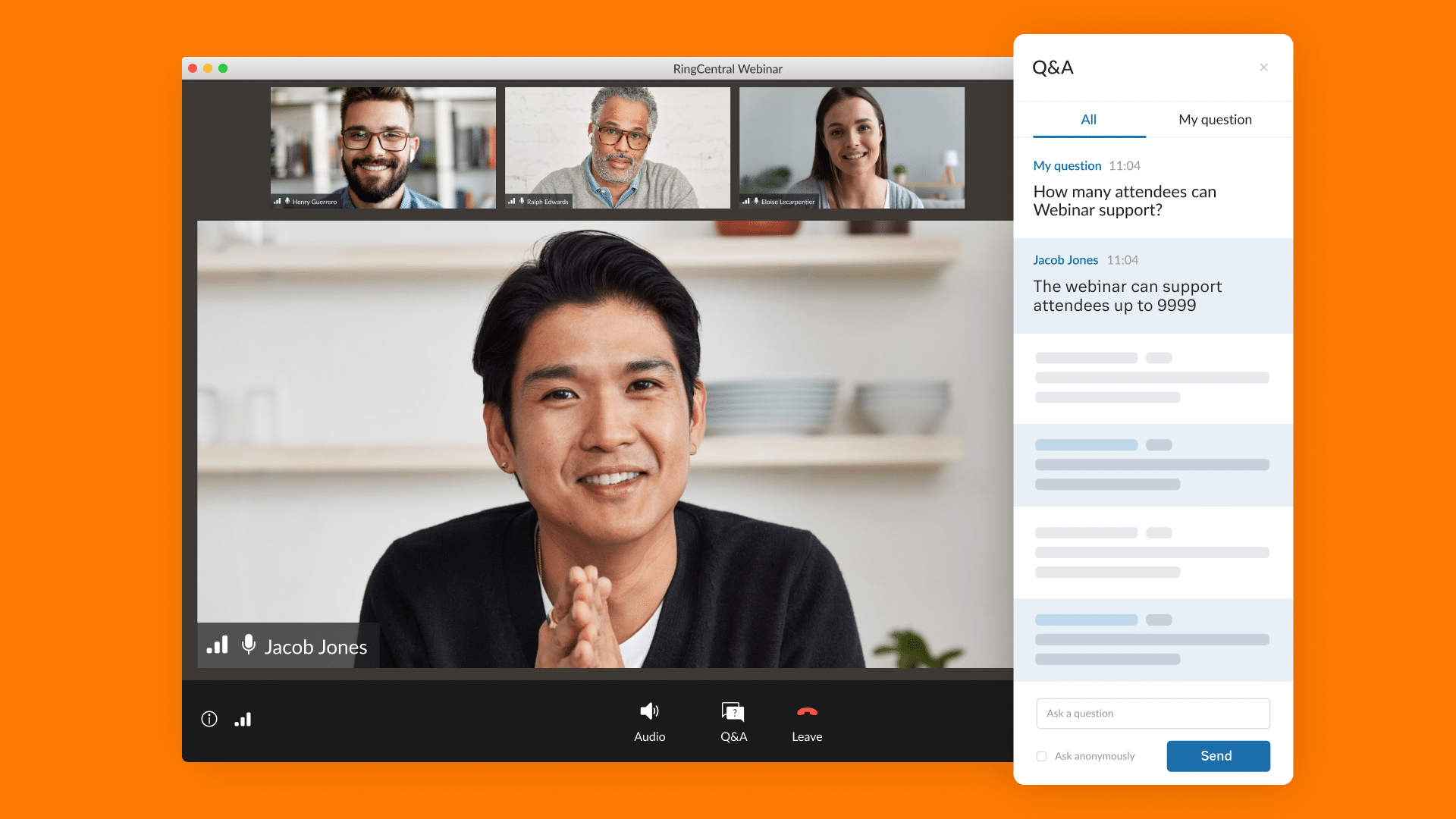Does the word ‘corporate’ scare you? How about ‘corporate event planning?’ Are there visions of clipboards or dull keynotes dancing in your head?
While anything dubbed ‘corporate’ might conjure images of pantsuits and cubicles, fight the urge to equate it with ‘stiff’ and ‘boring’ –– especially when it comes to corporate event planning.
After all, the Red Bull Cliff Diving World Series –– or any Red Bull event for that matter –– is a corporate event. And we can probably all agree planning that experience was anything but boring.
In simple terms, corporate event planning is the process of organizing events for a brand or business to achieve business goals.
Here are a few examples of areas a business might be looking to make progress in by hosting a corporate event:
- Brand awareness: A branded pop-up or conference session can make a splash. Take Bala’s Disco event for SXSW 2022. The workout brand hosted a party with exercise classes, cocktails, and dancing to capture attention and increase brand recognition.
- Thought leadership: Gatherings like The Atlantic Festival are designed to position event hosts as experts, leaders, and shapers in their field.
- Lead generation or customer retention: Ever been to a car show like the North American International Auto Show? Big companies like Ford and Toyota use those spaces to reimagine the sales process, reach new customers, and retain current ones.
- Employee engagement: Whether you’re reinforcing company values or fostering collaboration, internal corporate events can go a long way in making your company a stand-out place to work. Holiday parties, milestone celebrations, and team offsites are all corporate events.
Ready to start planning? We’ve outlined a corporate event planning roadmap and a free checklist to help guide you through the process. But first, let’s do a deeper dive on different types of corporate events and how to think about your planning timeline.
In this guide:
The many faces of corporate events
How to make sure time is on your side
How to plan a successful corporate event
Your corporate event planning checklist
How technology can uplevel your corporate events
The many faces of corporate events
Before looking at the planning process, it’s important to set clear goals and objectives so you understand what type of corporate event might be right for your business needs.
Corporate events, like the corporations they’re associated with, come in a variety of shapes, sizes, and types. They can be internal, geared toward employees or internal stakeholders, or external, delivered to a broader audience or the general public. They can also be in person, hybrid, or virtual –– the format largely depends on the goal of the event.
Let’s run through some common types of corporate events:
- Conferences: These experiences typically happen annually and they’re big-name, big-effort events that can take months to plan. They often involve sponsors, and usually include packed agendas featuring thought leaders and expert commentary. As an example, check out how the World Wide Fund for Nature chose a virtual conference format to bring debates on ecological issues, expert presentations, and a sponsor expo to their international audience.
- Product launches: If you’re introducing a new product or service, a launch event can help build excitement and drive adoption or sales. That’s what marketing agency N6A found when they helped their client launch a product — a cannabis-focused careers platform — via a virtual event.
- Trade shows: These tend to work best when companies want to demo products, meet prospects, and network with peers all at once.
- Internal meetings: Internal company meetings can be focused on specific teams –– think training sessions or offsites. But they also include company-wide experiences (an all-hands meeting, for example) and events designed for a company’s key stakeholders, like board meetings or investor updates. They can happen at scale: GitHub’s company-wide event featured more than 1,100 virtual attendees around the world.
- Training workshops: From internal security trainings to external product workshops, training events are often designed to be hands-on and participatory. The Flemish Department of Education and Training, for example, runs cultural education training events for students and teachers.
- Fundraising events: With galas, benefits, danceathons, silent auctions, food drives, and more, the corporate events side of charitable giving or fundraising can take many forms.
- Webinars: These events are focused on conveying information to an audience, whether it’s a presentation, walk-through, demo, or video.
- Team-building events: These events typically focus on building morale and positive rapport across a team — from scavenger hunts to talent shows, there’s no shortage of ways to bring employees together to help build bonds.
- Customer Advisory Board events: Customer Advisory Board events (also known as CABs) — and other kinds of focus group-centric gatherings — bring consumers together to give feedback, perspective, and advice to a company.
When planning any corporate event, there’s one thing you’ll want to make sure you have enough of: time.
How to make sure time is on your side
When do you need to start planning your corporate event?
That depends entirely on how complex it’s going to be, the amount of people you’re expecting, the size of your team, and the format of your event. Note that completely virtual corporate events won’t require physical spaces, travel arrangements, and other logistics specific to in-person experiences, so they can take less time to plan.
Consider the below as broad guidance:

And this breakdown of key components you’ll need to tackle:
- Getting universal buy-in: Stakeholders will need to be on the same page about the goals of your event, which can take time.
- Marketing your event: From email campaigns and social media messaging to paid advertisements and beyond — even if it’s an internal event — you’ll want to build excitement and rack up registrations for the big day.
- Sourcing speakers. Need a big name that can live up to the expectations of your 100,000 attendees? Start planning early. Even for small events, subject matter experts are in high demand and need quite a bit of notice.
- Landing sponsors: Sponsors don’t just fill out an expo hall; they can make events profitable. But finding good ones takes time, especially considering that companies often have limited budgets for sponsorship. Seek to secure sponsors as early as possible.
- Locking in your technical setup: You don’t want to be dealing with technical difficulties on event day. So, you’ll want to work through your setup long before showtime — everything from how you’ll handle audio and video for speakers to how you’ll respond to audience tech issues.
- Branding your event: Event branding makes it clear to would-be attendees what your event stands for. For virtual events, key branding elements will be entirely digital, like designs for your virtual event platform. In-person event branding will require even more time, as you’ll need to consider things like signage and other physical materials. No matter what type of corporate event you’re producing, make sure your brand shines on your event website.
- Planning food and beverage: Food and beverage, especially at an in-person or hybrid event, takes time to organize as there are multiple factors to consider: menu, pricing, catering company, sustainability, health and wellness, and more.
Remember, the amount of time it takes to bring your event to life also depends on the size of your team. If it’s just you, aim to give yourself the gift of plenty of buffer room.
If there are a few dozen corporate event planners and organizers working with you, it’s possible you’ll find yourself speeding through your timeline.
How to plan a successful corporate event
Now that you’ve moved through some prep, you’re ready to start planning in earnest. Let this step-by-step tutorial help you conquer corporate event planning.
Step 1: Define success
You can’t know the right format for your corporate event until you know what your desired outcome is.
So, ask yourself a few questions: What’s the intended outcome of this event? What business objective are we driving toward?
Write your goals in the S.M.A.R.T. framework:
- Specific: A specific goal narrows down the type of success an event organizer seeks.
- Measurable: A measurable goal typically relates to how you’ll evaluate the goal in a quantitative way.
- Achievable: Once a goal can be measured, you’ll be able to define what will indicate the goal has been achieved.
- Relevant: A relevant goal ensures buy-in from your various stakeholders.
- Time-bound: Setting a time-bound goal means that the goal is aligned with a specific timeframe so anyone reviewing it or acting upon it knows the deadline.“
Step 2: Develop your budget
Once you’ve nailed down the results you’re aiming to achieve, it’s time to build out your event budget.
An event budget helps you determine if you have the financial resources needed to bring your event to life and achieve the goals you’ve outlined.
You’ll break your budget into expenses and revenue.
Primary expenses will include:
- Marketing
- Logistics
- Venue (whether virtual, via a tech platform, or physical)
- Food and beverage
- Speakers and entertainment
And your main sources of revenue will usually come from:
- Sponsorships
- Ticket sales
- Product sales
Before you finalize your budget, add a contingency cost buffer (10-15% of the total is usually advised) for unexpected expenses.
Use an event budget template to collect all your numbers in one place, then send the final draft off to your stakeholders for final approval.
Step 3: Do a deep dive on what your audience wants
An event is almost always about the audience.
Whether your audience is primarily prospects, customers, employees, or industry peers, it’s full of people looking for value. That value could be emotional, social, educational, or something else altogether. And the success of an event is often determined by how much value it drove for its audience.
So, first you need to figure out what your audience really cares about.
If you can, go directly to the source by sending surveys to your email lists, asking for feedback on social media, and hosting focus groups with would-be attendees.
Or take a more quantitative approach and build a picture of your audience’s motivations, needs, values, and goals using platforms like Google Analytics, Facebook Audience Insights, and Nielsen.
Consider questions like:
- What motivates your audience members?
- What problems do they need help solving?
- What kind of people are they interested in learning from or connecting with?
- Are there community leaders who could bring them together?
- What’s most relevant for your audience right now?
Add an audience demographics layer, too. Look at:
- Geography: Where does your audience come from? Consider countries, cultures, and languages.
- Career: What industry does your audience work in? What experience levels do they have? What do they already know and what’s most relevant to their learning?
- Gender: What is the gender breakdown? Do you have equal representation?
Constantly ask yourself: Are there things you can do to make sure everyone who’s part of your audience feels comfortable and included? Consider how you’ll make your event as accessible as possible.
Step 4: Design for engagement
Events are experiences.
Think of the most magical events you’ve been to: maybe it was a wedding that felt like a fairytale, a championship game where you were swept up in the collective energy, a product launch party where you met your new business partner.
Events become magical when they are grounded in the audience’s values, and when they’re designed to engage people.
When designing your event, think about:
- Theme: Tie your event together with a fun event theme that will resonate with your audience.
- Stand-out content: If your content falls flat, so will the rest of your corporate event. Focus on providing the very best event content so all your attendees are passively engaged during less active sessions.
- Participation: What opportunities are you giving your audience to interact with your content? Can you add in workshops, breakout Q&A sections, or even get people started with some thought-provoking pre-written questions?
- Community: How will your attendees get to know one another? Consider adding a networking session in the middle of your event to encourage conversation and debate on your first set of topics.
- Co-creation: You want your audience to feel like they are owning the success of your event right along with you. According to industry experts, a key trend for successful events in 2022 and beyond is giving attendees the chance to make something they can take home with them — whether literally or figuratively.
- Technology: You have no shortage of tech options at your fingertips to make your event something folks will remember. Will you add a virtual reality expo space to explore? A digital photobooth? Artificial intelligence-enabled matchmaking for networking?
Step 5: Choose the right venue
You want people to feel welcome at your event. So choose a space that conveys that message.
In-person space considerations include size and cost, as well as:
- Wi-Fi and technical support: Do you have what you need to make sure the technical side of your event runs smoothly, and that attendees will be able to stay connected throughout the experience?
- Food and beverage options: What can you offer attendees and how does it meet dietary, wellness, and sustainability expectations?
- Health and safety: Returning to in-person events requires a lot of forethought, and a key consideration is the level of health and safety policies required and desired.
- Location: How easily will attendees be able to get to your event?
Virtual and hybrid venues have their own set of considerations:
- Capacity: How many attendees can participate at once?
- Customization: A virtual venue should be easier to customize than an in-person one (no architects or interior designers needed). Can you add custom graphics? Names? Spaces?
- Tech: Are live-streaming capabilities built into the platform of your choice? What about networking options? Live chats and polls?
- App integrations: Can you combine your marketing software with your virtual event management software? What about gamification tools, data analysis, and more?
Virtual events tend to open up possibilities for attendees and speakers since the potential audience becomes anyone with an internet connection. You can bring together a diverse audience and give them multiple ways to interact with one another and your content, including:
- Networking spaces
- Virtual expos and fairs
- Workshops
- Keynotes
- Q&As
- Live chats
- Polls
- Games and challenges
- Options to rewatch content after the event
Step 6: Promote your experience
Effective event marketing and branding can play a big role when it comes to filling up your registration list and getting attendees excited for your live event. These tools help illustrate what your event will be about and convince audience members of the value it will deliver.
When marketing to your audience, call on the knowledge you uncovered about their values, motivations, and goals.
For example, if you’re promoting a fun employee event like Greenhouse’s employee offsite, you might do a text-heavy drip campaign of emails explaining the various games that await participants: in this case, Zombie Battle, Salty Telephone, and Beg, Barter, Solve.
But if you’re promoting a more serious event, like the UN Climate Change Conference, you might lean on sparse graphics with provocative messaging to create eye-catching advertisements.
It’s not just emails and advertisements, either. Event promotion often requires an integrated, layered effort featuring an event website, email marketing, social media marketing, influencer engagement, and more.
However you decide to approach event marketing, get started early. You’ll want attendees to have time to plan –– and you’ll want to give yourself some runway in case you need to tweak your approach along the way.
Step 7: Tackle logistics for the live show
It’s all in the details.
Running through potential scenarios could be the difference between your audience struggling to hear a speaker whose microphone died, and said speaker delivering the most engaging presentation of your corporate event.
While event promotions continue running to drive registrations, it’s time to coordinate the rest of the event’s logistics.
Logistical to-dos might include:
- Finalizing your event’s agenda
- Creating your run-of-show document
- Setting up your virtual event environment
- Coordinating presentations with speakers
- Completing your on-site venue coordination
- Confirming and organizing audio/visual (A/V) production needs
- Doing dry runs and tech checks with presenters and hosts
- Nailing down any remaining experiential elements and things that might need to be mailed out to attendees, like swag
The list goes on.
Step 8: Put on a memorable experience
This is where it all comes together. Months of hard work, planning, and coordinating all culminate in attendees gathering for your experience.
Day of, you’ll want to make sure your team members are on the same page regarding their roles and responsibilities. Make sure you talk to:
- On-site staff, including event producers, emcees, hosts, reception workers, speaker liaisons, lead event managers, A/V technicians, guest relations coordinators, sponsor coordinators, and more
- Virtual staff, including producers, emcees and moderators, speaker liaisons, technical support, and chat managers
- Hybrid staff, including anyone supporting the coordination between experiences
Make sure the lines of communication stay open as your event is happening in case anything goes awry and needs to be addressed in the moment. Coordinating through software such as Slack, Microsoft Teams, WhatsApp, or Walkie Talkies (for those in a physical venue), will make sure you’re on top of any issue.
Step 9: Evaluate your event’s results
As you celebrate a successful corporate event, remember to debrief with your team and complete post-event reporting for your stakeholders. Take a look at data and analytics to measure your event’s performance.
Look at event data like:
- Attendance: The percentage of registrants who actually attended the event
- Average time spent in the event: How long participants stayed at your event
- Visitor numbers: Unique visitors to different areas of the virtual venue, like keynotes and sponsor expos
- Connections made: How many participants connected with one another
- Event Net Promoter Score (NPS): A number from 1-10 that tracks how satisfied attendees were with an event and how likely they are to refer that event to others or attend again
If you use a virtual event platform, the above data should be easy to pull together. Once you have your data, collect it in a post-event report to help you — and importantly, your stakeholders — evaluate how well your event performed relative to its goals and objectives.
Follow up with thank you notes and surveys to make sure you get feedback on what your participants enjoyed –– and what you can improve next time.
Your corporate event planning checklist
A corporate event planning checklist is a simple tool that can help you keep track of all the details in front of you, and make sure you’re ahead of the game when it comes to organizing your next corporate event. Consider these tasks as you navigate the process:
6-12 months out
- Determine your event’s goals and objectives
- Set your objectives, key results, and metrics
- Decide what type of event would best meet those goals
- Decide on theme and creative direction
- Create a budget and get approval from your stakeholders
- Set a date and time
- Start planning your location or venue
5-6 months out
- Finalize venue and vendors
- Identify speakers and start reaching out to them
- Start looking for sponsors and reach out to them
- Kick off your event branding, create a style guide, and start designing assets
3-5 months out
- Build event website
- Start event marketing and promotions to drive registration
- Finalize speakers
- Finalize sponsors
- Update your budget
1-3 months out
- Finalize details and logistics
- Source physical and virtual swag
- Update safety protocols, if necessary
0-1 month out
- Do final run-of-show rehearsals
- Get in sync with your event team on roles and responsibilities during the event
- Communicate final details to attendees
- Run final teaser campaigns
- Run last-minute promotions to fill any unclaimed spots
Post-event
- Send attendee survey and thank you notes
- Send speaker gifts and thank you notes
- Schedule debrief with stakeholders on event performance against goals
- Update budgets, run-of-show, and processes for your next event
- Use event content to fuel marketing activities and branding campaigns
How technology can uplevel your corporate events
You don’t have to go it alone when it comes to planning corporate events.
The right event technology can simplify the corporate event planning process and support you as you create the best attendee experience possible.
See how RingCentral Events leading event platform can help you achieve success with every type of corporate event –– whether it’s virtual, hybrid, or in person. Contact our team of corporate event experts today to learn more.
Originally published Sep 01, 2022, updated Oct 20, 2024





